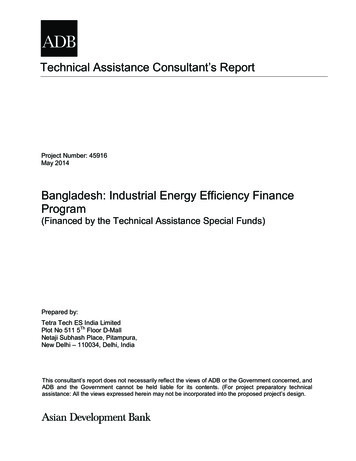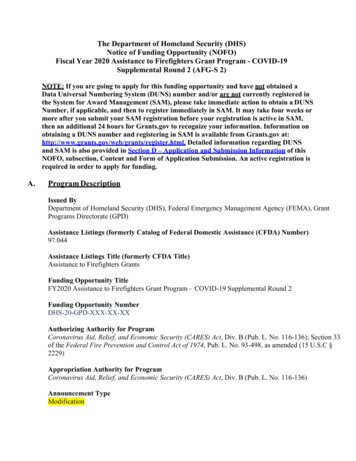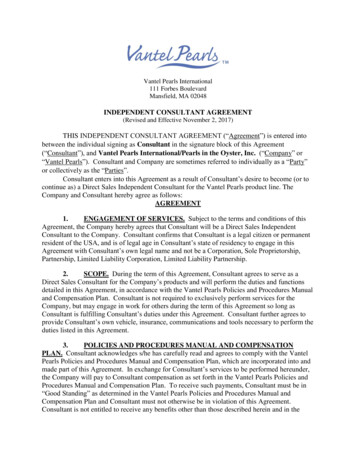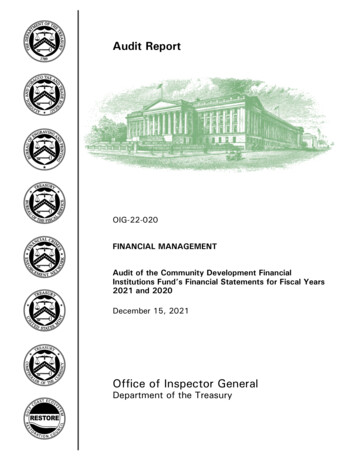
Transcription
Technical Assistance Consultant’s ReportProject Number: 45916May 2014Bangladesh: Industrial Energy Efficiency FinanceProgram(Financed by the Technical Assistance Special Funds)Prepared by:Tetra Tech ES India LimitedPlot No 511 5Th Floor D-MallNetaji Subhash Place, Pitampura,New Delhi – 110034, Delhi, IndiaThis consultant’s report does not necessarily reflect the views of ADB or the Government concerned, andADB and the Government cannot be held liable for its contents. (For project preparatory technicalassistance: All the views expressed herein may not be incorporated into the proposed project’s design.
complex worldCLEAR SOLUTIONSTMIndustrial Energy EfficiencyOpportunities and Challengesin BangladeshFinal Report2014Prepared by:Tetra Tech ES, Inc.1320 North Courthouse RoadSuite 600, Arlington, VA 22201United StatesWeb: www.tetratech.comConfidentiality and Privacy :This document has a restricted distribution and may be usedby recipients only in the performance of their official duties.Its contents may not otherwise be disclosed without AsianDevelopment Bank (ADB) authorization.
AcknowledgementThe Tetra Tech team expresses its sincere appreciation to the Asian Development Bank(ADB) for initiating the Bangladesh Industrial Energy Efficiency Finance Program andproviding guidance throughout its implementation. The team wishes to convey thanks to theexecuting agency, Industrial and Infrastructure Development and Finance Company (IIDFC)Bangladesh for providing local financial guidance to the project.This report has been prepared on the basis of 120 energy audits carried out in Bangladeshiindustrial facilities and has benefited from the observations, comments and inputs of a crosssection of knowledgeable industry experts and stakeholders. We are grateful to Mr. MartinLemoine (Sr. Investment Specialist, Asian Development Bank) for his expert guidance instructuring the program. We would like to acknowledge the guidance and support receivedfrom Ms. Juliette Leusink (Investment Specialist, Asian Development Bank), in herassistance in framing key issues, participating in workshops in Bangladesh and providinginsightful comments on this report. We express our profound thanks to the BangladeshResident Mission Director, Ms. Teresa Kho and Mr. Maruf Hossain (Unit Head – Financeand Administration, Bangladesh Resident Mission) and his team for extending logisticssupport in organizing workshops and visits by international consultants.We are especially grateful for valuable time and unique insights provided by Mr. MatiulIslam, Chairman IIDFC. We thankfully acknowledge the cooperation shown by Mr.Asaduzzaman Khan, Managing Director IIDFC and Mr. Shafiqul Alam, Deputy Manager,Carbon Finance IIDFC in arranging informational meetings and facilitating the participation offinancial institutions and banks in the program’s workshops. The report benefited greatlyfrom discussions with a wide range of financial institutions and banks, industry bodies,factory owners, utilities and manufacturers.We express our profound thanks to Kazi Akram Uddin Ahmed, President, The Federation ofBangladesh Chambers of Commerce and Industry and Md. Delwar Hossain, Member,Bangladesh Electricity Regulatory Commission, who provided their blessing andencouragement to proceed in this novel program. It was the team’s honor to obtain theknowledge and guidance of such distinguished experts.Last but not least, we thankfully acknowledge the many individuals mentioned above, as wellas many more that remain unnamed, for extending the support needed to complete this taskin an orderly fashion.iFinal Report TA 45916-01 BAN Industrial Energy Efficiency Finance Program.
Table of ContentsExecutive Summary .vii1. Introduction . 12. Energy Efficiency in the Industrial Sectors of Bangladesh - External and Internal Drivers . 32.1.2.2.2.3.The Existing Energy Scenario in Bangladesh. 3Energy Efficiency Challenges and Opportunities in Bangladesh . 5Key Drivers for Energy Efficiency in Bangladesh . 83. Sector Outlook . 123.1.3.2.3.3.3.4.3.5.3.6.Sector 1: Textiles, Garments, Leather and Related Industries . 15Sector 2: Iron and Steel Industries . 24Sector 3: Cement and Clinker Industries. 32Sector 4: Ceramics and Glass Industries . 40Sector 5: Chemical, Fertilizer, Pulp and Paper, Plastics Industries . 49Sector 6: Agro-industries, Including Sugar and Jute Industries . 604. Policy Support. 704.1.4.2.4.3.4.4.4.5.4.6.4.7.India. 71Japan. 72The Netherlands . 73United Kingdom . 74United States . 74Bangladesh. 75Proposed Policy Package for Bangladesh . 765. Capacity Building for Promoting Energy Efficiency in Bangladesh. 805.1.5.2.5.3.5.4.5.5.5.6.A Need for Capacity Building . 80Project Findings . 80Top-Down Approach . 81Industrial Energy Efficiency Finance Program. 82Program Findings. 83Priorities for Capacity Building . 846. Conclusion . 85iiFinal Report TA 45916-01 BAN Industrial Energy Efficiency Finance Program.
Consultant TeamNameDesignationAsian Development Bank (ADB)Martin LemoineSr. Investment SpecialistJuliette LeusinkInvestment SpecialistIndustrial and Infrastructure Development Finance Company Limited ( IIDFC)Matiul IslamChairman, IIDFCAsaduzzaman KhanManaging Director, IIDFCShafiqul AlamDeputy Manager, Carbon Credit, IIDFCTetra Tech Consultant TeamRakesh Kumar GoyalTeam LeaderSumedh AgarwalDeputy Team Leader (International)Md. Allauddin Al AzadDeputy Team Leader (National)Zafrul SiddiqueDeputy Team Leader (National)David JonesTechnical Editor and Graphics ExpertT. Shankar NarayananInternational Sector Expert – Textile, Garment and LeatherR. VirendraInternational Sector Expert – Cement and ClinkerDr. Gurpreet GrewalInternational Sector Expert – Iron and SteelAnjan Kumar SinhaInternational Sector Expert – Agro-IndustriesInternational Sector Expert – Chemical and Fertilizer, PulpB. P Bhandaryand PaperNagesh Kumar JayaramuluInternational Sector Expert – Ceramics and GlassHamidul HaqNational Sector Expert – Textile, Garment and LeatherMd. Sarwar JanNational Sector Expert – Textile, Garment and LeatherMafizul HaqueNational Sector Expert – Cement and ClinkerMd. Asraf HussainNational Sector Expert – Cement and ClinkerFazlul HaqueNational Sector Expert – Ceramics and GlassMazharul IslamNational Sector Expert – Ceramics and GlassMd. KaikobadNational Sector Expert – Iron and SteelMd. Zane AlamNational Sector Expert – Iron and SteelNational Sector Expert – Chemical and Fertilizer, Pulp andM. RahmanPaperNational Sector Expert – Chemical and Fertilizer, Pulp andRageb AhsanPaperJ CharageeNational Sector Expert – Agro-IndustriesMd. A HamidNational Sector Expert – Agro-IndustriesiiiFinal Report TA 45916-01 BAN Industrial Energy Efficiency Finance Program.
GlossaryAbbreviationTerm3GGlobal Growth GeneratorADBAsian Development BankASMAmerican Standard MethodBACTBest Available Control TechnologyBCICBangladesh Chemical Industries CorporationBCMABangladesh Cement Manufacturer’s AssociationBCWMABangladesh Ceramic Ware Manufacturers AssociationBDTBangladeshi TakaBEEBureau of Energy EfficiencyBERCBangladesh Energy Regulatory CommissionBFABangladesh Fertilizer AssociationBGMEABangladesh Garment Manufacturers and Exporters AssociationBIEEFPBangladesh Industrial Energy Efficiency Finance ProgramBIPETBangladesh Institute of Plastic Engineering and TechnologyBITACBangladesh Industrial Technical Assistance CentreBJMABangladesh Jute Mills AssociationBJMCBangladesh Jute Mill CorporationBJSABangladesh Jute Spinners AssociationBKMEABangladesh Knit Manufacturers and Exporters AssociationsBMETBureau of Manpower Employment and TrainingBOIBangladesh Board of InvestmentBPDBBSECBangladesh Power Development BoardBangladesh Plastic Goods Manufacturer andAssociationBangladesh Steel and Engineering CorporationBSFICBangladesh Sugar and Food Industries CorporationBTMABangladesh Textile Mills AssociationCAAClean Air ActCCContinuously Cast BilletsCCAClimate Change AgreementCCCCriterion Continuous ConcentrationCCLClimate Change LevyCNGCompressed Natural GasCPPCaptive Power PlantCub. MCubic MeterDAPDi-ammonium PhosphateEAFElectric Arc FurnaceBPGMEAivFinal Report TA 45916-01 BAN Industrial Energy Efficiency Finance Program.Exporters
AbbreviationTermECAEnergy Conservation Act (India)EEEnergy EfficiencyEEAEnergy Efficiency Assessment ProgramEESLEnergy Efficiency Services LimitedEGBExhaust Gas BoilerEMBEnergy Mass BalanceEPCEnergy Performance ContractsEPBExport Promotion Bureau of Bangladesh,ESCOEnergy Service CompanyESMEuropean Standard MethodsEU ETSEuropean Union Emissions Trading SystemFEEEDFramework for Energy Efficiency Economic DevelopmentFYPFive Year PlanGCGalvanized Corrugated SheetsGDPGross Domestic ProductGEGGas Engine GeneratorGHGGreen House GasGIGalvanized IronGOBGovernment of BangladeshGPGalvanized Plain SheetsgplGrams Per LiterGSPGeneralized System of PreferencesHClHydro Chloric AcidHEMHigh-Efficiency MotorHSDHigh Speed DieselIDInduced Draft FansIFIIDFCILOInduction FurnaceIndustrial and Infrastructure Development and Finance CompanyInternational Labor OrganizationIMMInjection Molding MachineIREDAIndia Renewable Energy Development AgencyJVETSJapanese Voluntary Emissions Trading SystemKMPLKarnaphuli Paper Mills LimitedKWKilo WattLEDLight Emitting DiodeMSMild SteelNITTRADNational Institute of Textiles Training, Research and DesignNTLNational Tube LimitedOECDOrganization of Economic Cooperation and DevelopmentOPCOrdinary Portland CementvFinal Report TA 45916-01 BAN Industrial Energy Efficiency Finance Program.
AbbreviationTermPATPerform Achieve and TradePCCPortland Composite CementPPCPollution Prevention and ControlPPPPublic Private PartnershipREDARenewable Energy Development AgencyRMGReady Made GarmentSBRIShip Building and Recycling IndustriesSECSpecific Energy ConsumptionSREDASustainable Renewable Energy Development AuthoritySEPSuperior Energy Performance ProgramSMESmall and Medium EnterprisesTATechnical AssistanceTCETons of Coal EquivalentTOETons of Oil EquivalentTSPTriple Super PhosphateTTCTechnical Training CentreUSDUnited States DollarVFDVariable Frequency DriveVRMVertical Roller MillsWHOWorld Health OrganizationWTOWorld Trade OrganizationviFinal Report TA 45916-01 BAN Industrial Energy Efficiency Finance Program.
EXECUTIVE SUMMARYGoldman Sachs expects that within the next 50 years, 5 of the G-7 nations will be replacedby emerging economies. Many of these economies have large populations, cheap labor andhigh levels of productivity. The Bangladeshi economy, which has maintained 6% growth overthe last 10 years, possesses these characteristics, leading to the country’s inclusion inGoldman Sachs’ list of “The Next Eleven (or N-11)” - economies that are expected to have ahigh potential for driving global growth in the 21st century. Such growth has historically beenled by the industrial and services sectors. This sustained growth in recent years hasgenerated higher demand for electricity, transport, and telecommunication services, and hascontributed to widening deficits in the infrastructure and investments needed for futuregrowth.As per the projected growth and potential demand, the primary source of energy inBangladesh, compressed natural gas (CNG), is expected to last until 2030 1. The country isalready facing gas shortages however, in the form of low distribution pressure and delays innew industrial and residential gas connections . Because securing new sources of energywill take time, Bangladesh is in the process of promoting a more efficient use of existingresources, both on the supply and demand sides. On the supply side, power plants aremandated to increase efficiency and new coal reserves are under exploration. On thedemand side, industry has been made a key focus area for energy efficiency initiatives, asthe industrial sector directly and indirectly consumes about 40% of Bangladesh’s energy.Energy efficiency (EE) does not comprise a single market; it covers measures in a diverserange of end-user sectors, end-use equipment and technologies and over a very largenumber of small, dispersed projects represented by a wide range of decision makers.Overall, many EE technologies are relatively easy and fast to implement, technically provenand financially viable: if properly implemented, the investment costs are paid back over shortperiods through energy cost savings. Yet projects with compelling economic returns remainunimplemented. Major causes for this gap are the lack of EE finance and deliverymechanisms that suit the specifics of the EE projects and a lack, in some markets, ofpipelines of bankable energy efficiency projects.The financing for energy efficiency projects in Bangladesh is gaining momentum and hasincreased with the adoption of improved models from developed countries. Driving this trendis development assistance from donor-funded agencies that are ready to offer loans tobanks and financial institutions (FI) for on-lending to suitable energy efficiency projects orconducting demonstration projects based on energy audits. However, to make EE financingsustainable, FIs and banks need to increase technical know-how regarding the appraisal ofenergy efficiency projects, performing evaluations based on energy units rather thancurrency (BDT v/s Cubic Meter), and exploration of new financing products.The Bangladesh Industrial Energy Efficiency Finance Program is one such effort by theAsian Development Bank (ADB), which has extended a non-sovereign loan facility andtechnical assistance to the Industrial and Infrastructure Development Finance Company(IIDFC) and other financial institutions for on-lending to eligible energy efficiency projects.1Energy and Power Fortnightly Magazine, 2013viiFinal Report TA 45916-01 BAN Industrial Energy Efficiency Finance Program.
The ADB has engaged Tetra Tech ES, Inc., United States (‘The consultant’); in associationwith Sodev Consult, Bangladesh; the National Productivity Council, India; and the ElectricalResearch Development Association, India; to provide technical assistance (TA) on EE to 120companies, IIDFC, other financial institutions and banks under TA 45916-01 BAN IndustrialEnergy Efficiency Finance Program.This program focuses on six target industrial sectors that show large savings potential inBangladesh. These industrial sectors include: Sector 1: Textiles, garments, leather, andrelated industries (hereon referred to as textiles); Sector 2: Steel, iron, and related industries(steel); Sector 3: Cement, clinker, and related industries (cement); Sector 4: Ceramics,glass, and related industries (ceramics); Sector 5: Chemicals, fertilizers, pulp and paper,plastic, and related industries (chemicals) and Sector 6: Agro-industries, including foodprocessing, sugar, pulp and paper, and jute (agro-industries).The focus under this program is to identify and suggest global best practices in energyefficiency improvement technologies relevant to these sectors. This includes the selection of120 target industrial clients, followed by energy audits, an economical and technicalanalysis, feasibility studies and recommendation reports prepared for those target clients.The consultant conducted energy audits of 120 industrial facilities, about 20 in each sector,and created bankable energy efficiency reports and recommendations that can form thebasis of a business model acceptable to financial institutions, helping to advance clientobjectives. In order to increase the knowledge on EE financing within IIDFC and raise theawareness of other financial institutions and banks, the consultant team conducted threecapacity building workshops throughout the contract period of the program. The firstworkshop laid the foundation by creating awareness of drivers, barriers, policy frameworksand energy audits. As part of this program, a financing manual has been prepared tospecifically address the concerns of bankers who would like to consider extending loansbased on cash-flow analysis, rather than just asset-based analysis. This manual presentsaround 12 financial tools based on the high potential opportunities identified for each sector.The second workshop provided step-by-step walkthroughs on the operation of the financialtools. We believe these tools will bridge the gap among FIs regarding the analysis of EEprojects based on energy units rather than currency.The third workshop presented case studies from each of the six sectors, paying specificattention to key areas of potential savings. The workshop participation was extended to the120 audited companies, as well as industrial associations, financial institutions and banks inorder to increase the extent of awareness and foster engagement among stakeholders.A team of 25 consultants, comprising national and international experts, worked fromDecember 2012 to November 2013 to achieve the objectives of this program. Theculmination of the consultant’s efforts is represented in this sector outlook report whichcharacterizes each sector by its principal types of industries, their end products, the currentstate of processes, technology and equipments in use, sources of energy, specific energyconsumption and opportunities for energy conservation, investment potential and humanresources capacity. It also highlights the opportunities for energy conservation, expectedgains and the investments required in each sector. The results of the 120 companies auditedare summarized in Figure E.1viiiFinal Report TA 45916-01 BAN Industrial Energy Efficiency Finance Program.
Figure E.1: Summary of audit findings by sectorSectorSector 1 – Textiles,Garment & LeatherSector 2 – Steel &IronSector 3 – Cement& ClinkerSector 4 –Ceramics & GlassSector 5 –Chemicals,Fertilizer, Paperand PlasticSector 6 – Agroindustries includingFood Processing,Sugar, Pulp, Paperand JuteTotalCompanies InvestmentAnnualAudited OpportunitySavings(No.)(USD million) (USD s(%)Avg.Pay ough the concept of energy efficiency has been boosted through this program, additionalfocus will be required on capacity building and policy approaches. Perhaps the biggest driverfor the Bangladesh Industrial Energy Efficiency Finance Program remains the impact ofanticipated energy shortages on the country’s growth due to loss of production. Anappropriate skill level among the local workforce will be required in order to executesuccessful EE projects, which must be accomplished through capacity building andoutreach. Furthermore, it was found that there is a need for a database of EE resourcematerials and the development of accreditation systems.Achieving the economic potential of energy efficiency is complex. Market players havedifferent approaches and different priorities. Energy efficiency per se is usually not a majorconsideration in investment decisions, except during periods of crisis when it is often toolate. In a crisis, demand can quickly be reduced by restricting services. But, improved energyefficiency at a regional or national level has to occur through a thoughtful, planned approachover a fairly long period. Policy and supporting measures are necessary to increaseindustrial energy efficiency in Bangladesh. Therefore, the consultants have suggested apolicy-based approach which defines policies and supporting measures to be adopted innear term. The challenges and opportunities regarding drivers of energy efficiency, policysupport and capacity building are also addressed in this report.Through the analytical evidence gathered during the energy audits, discussions withstakeholders (factory owners, policy makers, entrepreneurs, financial institutions), and dueattention and planning, this Industrial Energy Efficiency Finance Program has exposed anuntapped potential which can augment Bangladesh’s growth rate over the next three to fiveyears.ixFinal Report TA 45916-01 BAN Industrial Energy Efficiency Finance Program.
1. INTRODUCTIONIncreasing industrial energy efficiency is an effective way for Bangladesh and its utilities toachieve significant cost savings, particularly in regions that have not fully taken advantage ofthe simplest and least expensive efficiency measures. Bangladesh consumed an estimated4,980 MW of electricity in 2012, around 12% more than in 2011. Approximately 40% of thetotal electricity consumed in 2012, around 1,990 MW, was used by the industrial sector. This1,990 MW of energy consumption represents a unique energy-saving opportunity forBangladesh, because the industrial sector’s energy consumption is the primary means togrowing the economy country wide2. This energy consumption allows for a much higherreturn on investment for energy efficiency improvements when compared to reducing energyconsumption in the commercial and residential sectors, where energy consumption is farless concentrated. Put another way, the energy that is locked into inefficient systems andprocesses is limiting economic growth in Bangladesh.Due to the relatively low and subsidized energy prices, the commercial use of energyremains inefficient and wasteful. To reduce energy wastage, proper incentive structures willhave to be designed and regulation made to be far more effective. This is a technological aswell as a regulatory challenge. The potential for cost and energy savings, however, arehuge. Access to finance is still an issue as financial institutions are not familiar with this lineof credit and potential of this low risk business opportunity. For example in India, energyefficiency financing represents a business case of USD 250 billion to financial institutionsand banks3.To address these concerns, the ADB’s Bangladesh Industrial Energy Efficiency FinanceProgram (BIEEFP) focuses on six target industrial sectors that show large savings potentialin Bangladesh: Textiles; Iron and steel; Cement and clinker; Chemicals; Ceramics and glassand Agro-industries. These sectors are highly energy intensive and have tremendousopportunity to reengineer technological processes, enhance manpower and improvemanagement capacity. The focus under this program is to identify and deploy global bestpractices in energy efficiency improvement technologies relevant to these private sectorsand establish investment opportunities for interested financial institutions.Identifying the characteristics of each sector allows energy efficiency program managers andfinancial institutions to more easily develop programs based on the unique attributes of theirservices. This report attempts to address this objective. More importantly, thiscomprehensive compendium will provide a valuable resource for planners and policy makersacross the country to develop programs with a better understanding of industrial energyconservation measures, appropriate energy saving targets, the role and need for capacitybuilding and gains to be expected from such programs. Furthermore, this report will allowtechnology providers to anticipate the key technologies that will impact the efficiencypotential of the target sectors. In summary, this report begins to outline the savings potentialinherent to each sector by utilizing readily identifiable and available energy efficiency23Bangladesh consumes 41% of natural gas in the industrial sector.Bureau of Energy Efficiency, India1Final Report TA 45916-01 BAN Industrial Energy Efficiency Finance Program.
improvement technologies. The report also presents investment, annual savings, internalrate of return and carbon savings expected from each sector in the implementation of energysaving measures. This will help managers at financial institutions and banks to justify theiractive participation in energy saving programs.This report aims to characterize each sector by its principal types of industries, their endproducts, the current state of processes, technology and equipment in use, sources ofenergy, specific energy consumption and opportunities for energy conservation, investmentpotential and human resources capacity. These characteristics will be examined todetermine their influence on investment, savings and expected gains for each sector and onthe success of prospective programs. A variety of companies were visited to conduct energyaudits of their facilities, gain insights into their efficiency programs, understand their presentpractices and identify gaps in capacity. The resulting sectoral analyses, included in thisreport, helps to form a picture of the best practices in each sector as well as the state ofspecific energy consumption with respect to global benchmarks. Companies that areinterested in initiating or expanding their industrial efficiency program will be able to use thisreport and the results of BIEEFP in determining which energy conservation measures willoffer the greatest return on investment. For banks and financial institutions, this will in turnhelp to identify projects with a high rate of return and low risk. We have also includedchapters on: external and internal drivers for industrial efficiency in Bangladesh, policysupport and capacity building.These chapters will be useful to policymakers inunderstanding how the region’s unique characteristics can shape policy and ultimatelyinfluence the drive and commitment of industries towards improving energy efficiency.2Final Report TA 45916-01 BAN Industrial Energy Efficiency Finance Program.
2. ENERGY EFFICIENCY IN THE INDUSTRIAL SECTORS OFBANGLADESH - EXTERNAL AND INTERNAL DRIVERSDeveloping countries around the world are projected to account for around 87% of theworld’s primary energy demand growth by 2030. Much of this growth in energy demand willoccur in Asia, which is witnessing rising populations, high economic growth and rapidurbanization. Many countries are averse to the notion of energy conservation and efficiencyand consider it their priority to first ensure economic growth through higher production andharness new energy sources, dealing with energy savings later.Refuting this approach, however, is a recent analysis which concludes that economicproductivity is more closely tied to energy efficiency than energy production4. Coupled withthis fact are the key drivers of energy efficiency in developing Asian countries: thecontinuous depletion of internal energy sources, rising volatile external energy prices,budgetary pressures due to energy subsidies and the need to mitigate the impacts of climatechange. Not surprisingly, then, that every segment of the Asian economy is increasinglyaware of the need for energy efficiency.Bangladesh, with a GDP growth rate of 6%, is conscious of this need and is well aware ofthe potential to build a diverse, energy efficient industrial sector. Bangladesh appreciates thefact that a well-conceived energy efficiency strategy will not only allow it to achieve its goalswith much lower energy consumption but will also enable it to improve the standard of livingand quality of life for its population.This chapter outlines the potential drivers to energy efficiency in the industrial sectors ofBangladesh. It considers the existing energy situation in the country, its burgeoning industrialoutput, the prevailing supply-demand imbalance and the external and internal drivers thatcan help energy efficiency to grow and prosper.2.1.THE EXISTING ENERGY SCENARIO IN BANGLADESHBangladesh has natural gas, coal and marginal oil reserves. Prior to independence, thecountry was touted as floating on natural gas. The availability of gas at low prices has playeda major role in the economic development of the country and in raising the social standardsof the population. It has also allowed the country to use this
National Sector Expert - Chemical and Fertilizer, Pulp and Paper J Charagee National Sector Expert - Agro-Industries Md. A Hamid National Sector Expert - Agro-Industries . CAA Clean Air Act CC Continuously Cast Billets CCA Climate Change Agreement CCC Criterion Continuous Concentration CCL Climate Change Levy CNG Compressed Natural Gas





![[CONSULTANT] (1) and - GOV.UK](/img/31/2015-2019-land-and-risk-management-panel.jpg)





